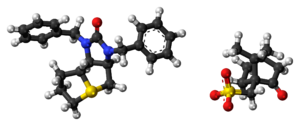Trimetaphan camsilate (INN) or trimethaphan camsylate (USAN), trade name Arfonad, is a sympatholytic drug used in rare circumstances to lower blood pressure.
 | |
 | |
| Clinical data | |
|---|---|
| Trade names | Arfonad |
| Routes of administration | Oral, IM, IV |
| ATC code | |
| Pharmacokinetic data | |
| Excretion | Renal, mostly unchanged |
| Identifiers | |
| |
| CAS Number | |
| PubChem CID | |
| DrugBank | |
| UNII | |
| KEGG | |
| ChEMBL | |
| CompTox Dashboard (EPA) | |
| ECHA InfoCard | 100.000.633 |
| Chemical and physical data | |
| Formula | C22H25N2OS (free base) |
| Molar mass | 365.52 g·mol−1 |
| | |
Trimetaphan is a ganglionic blocker: it counteracts cholinergic transmission at a specific type of nicotinic acetylcholine receptors in the autonomic ganglia and therefore blocks both the sympathetic nervous system and the parasympathetic nervous system. It acts as a non-depolarizing competitive antagonist at the nicotinic receptor, is short-acting, and is given intravenously.
It was discovered by Leo Sternbach.[1]
Effects
editTrimetaphan is a sulfonium compound and therefore carries a positive charge. Being charged, it cannot cross lipid cell membranes, such as those that comprise the blood–brain barrier. Due to this, trimethaphan does not have any effect on the central nervous system.
The ciliary muscle of the eye functions to round the lens for accommodation and is controlled mainly by parasympathetic system input. With administration of a ganglion-blocking drug, the ciliary muscle cannot contract (cycloplegia) and the patient loses the ability to focus their eyes.
Trimetaphan has a strong effect on the cardiovascular system. The size of blood vessels is primarily controlled by the sympathetic nervous system. Loss of sympathetic system input to the blood vessels causes them to get larger (vasodilation) which has the effect of lowering blood pressure. Postural hypotension is a common side effect of such drugs. Trimethaphan causes a histamine release which further lowers blood pressure. Effects on the heart include a decreased force of contraction and an increase in heart rate (tachycardia). Reflexive tachycardia can be diminished or undetected because trimetaphan is also blocking the sympathetic ganglia innervating the heart.
The motility of the gastrointestinal tract is regulated by the parasympathetic system, and blockage of this input results in diminished motility and constipation.
A rare side effect of trimethaphan administration is sudden respiratory arrest. The mechanism behind it is unknown, as trimethaphan does not appear to block neuromuscular transmission, and respiratory arrest is not an expected consequence of ganglionic blockage.[2]
Therapeutic uses
editThe therapeutic uses of trimetaphan are very limited due to the competition from newer drugs that are more selective in their actions and effects produced. It is occasionally used to treat a hypertensive crisis and dissecting aortic aneurysm, to treat pulmonary edema, and to reduce bleeding during neurosurgery.
References
editThis article includes a list of general references, but it lacks sufficient corresponding inline citations. (September 2018) |
- ^ Bause GS (1 August 2017). "From Coenzyme R to "Arfonad" and from Vitamin H to Hypotension". Anesthesiology. 127 (2): 381–381. doi:10.1097/ALN.0000000000001771. ISSN 0003-3022.
- ^ Dale RC, Schroeder ET (July 1976). "Respiratory paralysis during treatment of hypertension with trimethaphan camsylate". Archives of Internal Medicine. 136 (7): 816–8. doi:10.1001/archinte.1976.03630070060018. PMID 938175.
Further reading
edit- Anderson SM (July 1955). "Controlled hypotension with arfonad in paediatric surgery". British Medical Journal. 2 (4931): 103–4. doi:10.1136/bmj.2.4931.103. PMC 1980290. PMID 14378656.
- Kling TF, Wilton N, Hensinger RN, Knight PR (April 1986). "The influence of trimethaphan (Arfonad)-induced hypotension with and without spine distraction on canine spinal cord blood flow". Spine. 11 (3): 219–24. doi:10.1097/00007632-198604000-00007. PMID 3715622. S2CID 24029902.
- Moyer JH, Handley CA (April 1955). "Renal and cardiovascular hemodynamic response to ganglionic blockade with pendiomide and a comparison with hexamethonium and arfonad". The Journal of Pharmacology and Experimental Therapeutics. 113 (4): 383–92. PMID 14368507.
- Ulm AH (February 1959). "The treatment of primary priapism with arfonad". The Journal of Urology. 81 (2): 291–3. doi:10.1016/S0022-5347(17)66009-9. PMID 13631819.
- Petrides G, Maneksha F, Zervas I, Carasiti I, Francis A (March 1996). "Trimethaphan (Arfonad) control of hypertension and tachycardia during electroconvulsive therapy: a double-blind study". Journal of Clinical Anesthesia. 8 (2): 104–9. doi:10.1016/0952-8180(95)00192-1. PMID 8695090.
- Tewfik GI, Wells BG (July 1957). "The use of arfonad for the alleviation of cardio-vascular stress following electro-convulsive therapy". The Journal of Mental Science. 103 (432): 636–44. doi:10.1192/bjp.103.432.636. PMID 13449573.
- Rowe GG, Afonso S, Lugo JE, Boake WC (1964). "Systemic and Coronary Hemodynamic Effects of Trimethaphan Camphorsulfonate (Arfonad) in the Dog". Anesthesiology. 25 (2): 156–60. doi:10.1097/00000542-196403000-00008. PMID 14156542. S2CID 36791833.